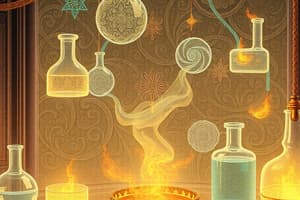Podcast
Questions and Answers
Which of the following statements is true regarding exothermic reactions?
Which of the following statements is true regarding exothermic reactions?
- Energy is a reactant.
- Reactants have less energy than the products.
- Energy is a product. (correct)
- Enthalpy change is always positive.
In an endothermic reaction, products possess less energy than the reactants.
In an endothermic reaction, products possess less energy than the reactants.
False (B)
What does the symbol ΔH represent in a chemical reaction?
What does the symbol ΔH represent in a chemical reaction?
Enthalpy change
An exothermic reaction has a __________ energy change.
An exothermic reaction has a __________ energy change.
Match the energy change type with its description:
Match the energy change type with its description:
What type of reaction is cellular respiration?
What type of reaction is cellular respiration?
Photosynthesis produces carbon dioxide and water.
Photosynthesis produces carbon dioxide and water.
What is the balanced equation for cellular respiration?
What is the balanced equation for cellular respiration?
Photosynthesis is an __________ reaction that requires energy.
Photosynthesis is an __________ reaction that requires energy.
Match the following terms with their definitions:
Match the following terms with their definitions:
Which statement is correct regarding enthalpy change (ΔH)?
Which statement is correct regarding enthalpy change (ΔH)?
Chemical reactions are not influenced by the coefficients in a chemical equation.
Chemical reactions are not influenced by the coefficients in a chemical equation.
What is the ΔH for the reaction 2 N2(g) + 6 H2(g) → 4 NH3(g)?
What is the ΔH for the reaction 2 N2(g) + 6 H2(g) → 4 NH3(g)?
Reactions with a positive ΔH are _____, meaning they gain energy.
Reactions with a positive ΔH are _____, meaning they gain energy.
Match the following chemical equations with their respective ΔH values:
Match the following chemical equations with their respective ΔH values:
What is the overall enthalpy change (
abla H) for the given reaction?
What is the overall enthalpy change ( abla H) for the given reaction?
Molar enthalpy can be expressed as the total enthalpy change divided by the number of moles.
Molar enthalpy can be expressed as the total enthalpy change divided by the number of moles.
What is the equation used to calculate enthalpy change?
What is the equation used to calculate enthalpy change?
In the equation $
abla H = nH_m$, the variable 'n' represents the _______.
In the equation $ abla H = nH_m$, the variable 'n' represents the _______.
Match the following terms with their correct definitions:
Match the following terms with their correct definitions:
What is the standard molar enthalpy of combustion of gasoline?
What is the standard molar enthalpy of combustion of gasoline?
The enthalpy change for burning 737 g of gasoline is positive.
The enthalpy change for burning 737 g of gasoline is positive.
How many moles of gasoline are in 737 g?
How many moles of gasoline are in 737 g?
The enthalpy change for burning one litre of gasoline is approximately __________ kJ.
The enthalpy change for burning one litre of gasoline is approximately __________ kJ.
Match the following quantities with their corresponding calculations:
Match the following quantities with their corresponding calculations:
What is the molar enthalpy of reaction for NiO(l) in the reaction 2 Al(l) + 3 NiO(l) → Al2O3(s) + 3 Ni(l) + 954 kJ?
What is the molar enthalpy of reaction for NiO(l) in the reaction 2 Al(l) + 3 NiO(l) → Al2O3(s) + 3 Ni(l) + 954 kJ?
Exothermic reactions absorb energy from their surroundings.
Exothermic reactions absorb energy from their surroundings.
What does the reaction 2 Al(l) + 3 NiO(l) produce?
What does the reaction 2 Al(l) + 3 NiO(l) produce?
In the reaction 2 Al(l) + 3 NiO(l) → Al2O3(s) + 3 Ni(l) + 954 kJ, energy is __________.
In the reaction 2 Al(l) + 3 NiO(l) → Al2O3(s) + 3 Ni(l) + 954 kJ, energy is __________.
Match the following substances with their role in the reaction:
Match the following substances with their role in the reaction:
What is the molar enthalpy of reaction for carbon dioxide in the fermentation reaction?
What is the molar enthalpy of reaction for carbon dioxide in the fermentation reaction?
The original source of energy stored in glucose is the Sun.
The original source of energy stored in glucose is the Sun.
How many kilograms of methanol are required to produce an enthalpy change of -9.00 x 104 kJ?
How many kilograms of methanol are required to produce an enthalpy change of -9.00 x 104 kJ?
In the reaction of methanol, the heat released is represented by ΔH = __________ kJ.
In the reaction of methanol, the heat released is represented by ΔH = __________ kJ.
Match the following components to their respective roles:
Match the following components to their respective roles:
What is the standard molar enthalpy of combustion, $ riangle H^ heta$, for ethyne?
What is the standard molar enthalpy of combustion, $ riangle H^ heta$, for ethyne?
The combustion of ethyne produces four moles of carbon dioxide and two moles of water.
The combustion of ethyne produces four moles of carbon dioxide and two moles of water.
What is the coefficient for $O_2(g)$ in the complete combustion of ethyne equation?
What is the coefficient for $O_2(g)$ in the complete combustion of ethyne equation?
In the given combustion reaction, ethyne ($C_2H_2(g)$) reacts with __________ gas.
In the given combustion reaction, ethyne ($C_2H_2(g)$) reacts with __________ gas.
Match the compounds with their respective coefficients in the combustion of ethyne:
Match the compounds with their respective coefficients in the combustion of ethyne:
Flashcards
Exothermic Reaction
Exothermic Reaction
A chemical reaction where energy is released into the surroundings, resulting in a decrease in the system's energy content.
Endothermic Reaction
Endothermic Reaction
A chemical reaction where energy is absorbed from the surroundings, resulting in an increase in the system's energy content.
Enthalpy
Enthalpy
The total internal energy of a chemical system, including both kinetic energy (energy of motion) and potential energy (stored energy).
Enthalpy Change (ΔH)
Enthalpy Change (ΔH)
The change in enthalpy (heat content) during a chemical reaction. It represents the heat absorbed or released by the system.
Signup and view all the flashcards
Relationship between enthalpy change and reaction type
Relationship between enthalpy change and reaction type
A positive enthalpy change indicates an endothermic reaction, where heat is absorbed by the system. A negative enthalpy change indicates an exothermic reaction, where heat is released by the system.
Signup and view all the flashcards
Stoichiometry and Enthalpy Change
Stoichiometry and Enthalpy Change
The enthalpy change is directly proportional to the amount of reactants or products involved in the reaction.
Signup and view all the flashcards
Cellular Respiration
Cellular Respiration
The process by which living organisms break down glucose to release energy in the form of ATP. This process occurs in the mitochondria of cells.
Signup and view all the flashcards
Photosynthesis
Photosynthesis
The process where plants use sunlight energy to create glucose (food) from carbon dioxide and water. This occurs in chloroplasts.
Signup and view all the flashcards
Enthalpy Change ($
\Delta H$)
Enthalpy Change ($ \Delta H$)
The change in energy content during a reaction. It's a measure of how much energy is released or absorbed.
Signup and view all the flashcards
Standard Molar Enthalpy of Combustion
Standard Molar Enthalpy of Combustion
The amount of heat released or absorbed when one mole of a substance undergoes a specific chemical reaction under standard conditions.
Signup and view all the flashcards
Molar Mass
Molar Mass
The mass of one mole of a substance, calculated from the sum of the atomic masses of all atoms in the molecule.
Signup and view all the flashcards
Density
Density
The ratio of the mass of a substance to its volume. It is a measure of how much mass is contained in a given volume.
Signup and view all the flashcards
Enthalpy Change
Enthalpy Change
The total amount of heat energy released or absorbed in a chemical reaction.
Signup and view all the flashcards
Number of Moles
Number of Moles
The number of moles of a substance present in a given mass.
Signup and view all the flashcards
Overall Enthalpy Change (Reaction Enthalpy)
Overall Enthalpy Change (Reaction Enthalpy)
Describes the enthalpy change for the complete reaction when all the amounts are in the chemical equation's stoichiometric ratio.
Signup and view all the flashcards
Molar Enthalpy (Hm)
Molar Enthalpy (Hm)
The enthalpy change per mole of a substance involved in the reaction. It's calculated by dividing the enthalpy change by the number of moles of the substance.
Signup and view all the flashcards
Potential Energy Diagram
Potential Energy Diagram
A diagram that illustrates the energy changes during a reaction. It shows the relative energy levels of reactants, products, and the activation energy.
Signup and view all the flashcards
Calculating Enthalpy Change
Calculating Enthalpy Change
The enthalpy change of a reaction can be calculated by multiplying the number of moles of the substance by its molar enthalpy.
Signup and view all the flashcards
Molar Enthalpy of Reaction
Molar Enthalpy of Reaction
The enthalpy change associated with one mole of a specific reactant or product in a chemical reaction.
Signup and view all the flashcards
Calculating Molar Enthalpy
Calculating Molar Enthalpy
The process of finding the enthalpy change for a specific substance in a chemical reaction. It involves dividing the total enthalpy change by the number of moles of that substance.
Signup and view all the flashcards
Negative Enthalpy Change
Negative Enthalpy Change
A negative value for enthalpy change indicates that energy is released from the system, resulting in an exothermic reaction.
Signup and view all the flashcards
Balancing a Chemical Equation
Balancing a Chemical Equation
The process of balancing a chemical equation by adjusting the coefficients in front of each chemical formula to ensure that the number of atoms of each element on the reactant and product sides are equal.
Signup and view all the flashcards
Coefficients in a Balanced Equation
Coefficients in a Balanced Equation
A balanced chemical equation shows the relative amounts of reactants and products involved in a chemical reaction. Coefficients represent the mole ratios.
Signup and view all the flashcards
Molar enthalpy of reaction (Hm)
Molar enthalpy of reaction (Hm)
The enthalpy change per mole of a substance in a chemical reaction. It tells you how much energy is released or absorbed for each mole of a specific reactant or product.
Signup and view all the flashcards
Sun
Sun
The original source of energy for glucose production in plants, providing the basis for energy storage in living organisms.
Signup and view all the flashcards



